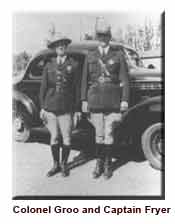A Growing Patrol
By 1935, the Patrol consisted of 37 employees as follows: Superintendent Groo, Captain Fryer, Lieutenant Hillis, seven sergeants, twenty-three patrolmen, one chief clerk, two assistant clerks and a stenographer. Applicants for the Utah Highway Patrol were required to pass a physical examination, an oral exam, and a written examination on general education subjects such as arithmetic, English and geography. Training was given to early recruits which included state laws, patrol methods, use of firearms, first aid, and care of equipment.
In 1935, the issued equipment was a .44 caliber Smith & Wesson revolver, cross-draw holster, handcuffs and case, sam brown belt, flashlight, ammunition, and first aid supplies. The Patrol was equipped with 19 police motorcycles and 27 coupe automobiles. Motorcycles were used during fair weather in the daylight hours and automobiles were used during inclement weather and at night. Two men were often assigned to work together on night patrol. All patrol cars were equipped with a tow chain, fire extinguisher, first aid kit, two red lanterns, red fusees, shovel and a broom for removing broken glass and debris from the highway.
In 1935, patrolmen were stationed at fifteen cities as follows: Logan, Brigham, Garland, Ogden, Farmington, Salt Lake City, American Fork, Provo, Spanish Fork, Price, Helper, Richfield, Fillmore, Cedar City and St. George. From these various locations the main adjacent highways were patrolled.
In addition to enforcement of traffic laws and liquor laws, in 1935, the Utah Highway Patrol issued license plates, gave driver license examinations, collected bus and truck line mileage taxes, collected gasoline taxes, supervised 250 safety inspection stations and conducted school bus inspections.
During the 1936 summer convention of the Utah Peace Officers Association, Whitney Groo was elected President. In 1937, the UPOA summer convention was held at Price, Utah. As President, Whitney Groo recognized the need for continuing education and training of all peace officers. President Groo always stressed professionalism and cooperation between agencies. With limited budgets and a depressed economy, coordinating efforts of city, county, state and federal agencies was of paramount importance.
